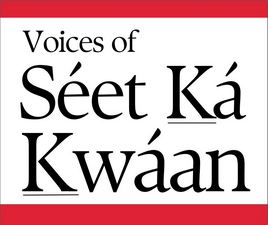
A Petersburg seafood business and some stream restoration work on Kuiu Island were among the nearly nine million dollars in project funding announced by the U.S. Department of Agriculture in March. That money will help move salmon and other seafood to buyers and pay for salmon habitat repair.
“Sea to Shore Seafood which is a veteran and women-owned business in Petersburg, which will use a $250,000 grant to distribute salmon products into new markets while remaining committed to sustainable, traceable fishing,” said the Agriculture Department’s under secretary for rural development Xochitl Torres Small announcing project awards under the Southeast Alaska Sustainability Strategy at a press conference in Juneau.
Sea to Shore Seafood Company is a direct marketing business run by husband and wife fishermen Pete and Chelsea Keutmann.
“I think the grant itself it kind of just felt like it was going to be too far out of reach but we thought you know we’ll go ahead and try and our business is unique enough and yeah we just went for it,” Chelsea Keutmann said in a recent interview. “And to actually be one of the recipients who actually received the full amount is really surreal,” she said.
Chelsea grew up fishing out Petersburg. By the time she was 18 she was running a family boat, gillnetting and doing some direct marketing of her catch. Pete was in the Coast Guard stationed in Petersburg when the two met and got married. They sell gillnet-caught salmon along with spot prawns, halibut and black cod at farmer’s markets and through home delivery in Washington state, and also ship to customers through their website.
The money will allow the couple to hire some help. Pete Keutmann said there are requirements for how it’s spent.
“You know as far as hiring people, helping with us cover processing costs, paying the local processors like Coastal (Cold Storage) and Tonka (Seafoods) in town that we work with,” he said. “And it also is going to enable us to build a new website platform that will allow us to ship nationwide. So we’re hoping that this will not only allow us to ship more of our fish but also helps us for the last couple years we’ve been buying from our fellow fishermen, will allow us to move more of our fellow fishermen’s fish, giving kind of everyone a little bit of ability to make a little more for their catch.”
The Keutmanns say they saw increasing interest from customers wanting to know the source of their seafood during the pandemic as COVID disrupted food supplies and people cooked at home instead of eating out. They’re hoping to spread information about the fishermen that will be supplying their company and getting help from a former Petersburg resident in their product labeling.
“I just feel like there’s such a mystery between you know the end consumer and the fisherman and what happens in between and so we want to be really forthcoming about that,” she said. “And actually with our rebranding and design we have Sage Drllevich actually who is doing some graphic design work for us and creating labels that will have actually fishermen specific faces on it with little scan codes to tell what type of fishing it was, where it was harvested and a story about the fishermen.”
Chelsea Keutmann says the grant will also allow the company to expand distribution in the Lower 48.
“With the grant money we actually just got the keys to a warehouse space here in Washington to actually act as more of like a distribution center for us because we want to be pushing and going for a nationwide distribution and shipping out of Petersburg has a lot of logistical issues around it,” she explained. “And so this will actually help us to have a staging point and then be able to offer next day shipping through FedEx or UPS and things like that. And so we’re really excited about that.”
The couple said the federal funding will also help with fulfilling orders and upgrading their packaging. The company has to match the grant money. The Keutmanns said they’re not looking to expand to compete with larger processors but will focus on selling a small part of the local catch to buyers looking for high quality seafood. They said it’s not an easy process to apply for the grant money but encourage direct marketers to seek out that kind of funding.
Another project in the area that was funded is salmon stream restoration work near Kake on Kuiu Island. It’s one of several that involve a partnership between the Southeast Alaska Watershed Coalition, the U.S. Forest Service and Alaska Native tribes. The coalition’s executive director Rob Cadmus said the plan is to replace woody debris in streams near areas that have been logged.
“And that wood is really important, the wood on the stream banks and the wood in the stream it provides diverse habitat essentially,” he explained. “It creates a diverse stream rather than a very simple stream without the wood in it. These kind of projects are mimicking the natural conditions to allow time for the trees that are on the side of the stream now to grow large enough that they can fall in and replace the habitat naturally.”
Just over half a million dollars ($505,000) will go to restore about two miles of Skanaxheen Creek and Shorty Creek on Kuiu. It’s work designed by Forest Service hydrologist Heath Whitacre of Petersburg and it’s likely another year or more before that restoration goes forward.
Other stream repair work funded under the Southeast Alaska Sustainability Strategy could happen this year. The SAWC is working with the Forest Service and the Ketchikan Indian Community on stream work on Margaret Creek north of Ketchikan. Multiple organizations are also involved in another partnership for stream repair on Kosciusko Island and near Klawock.











